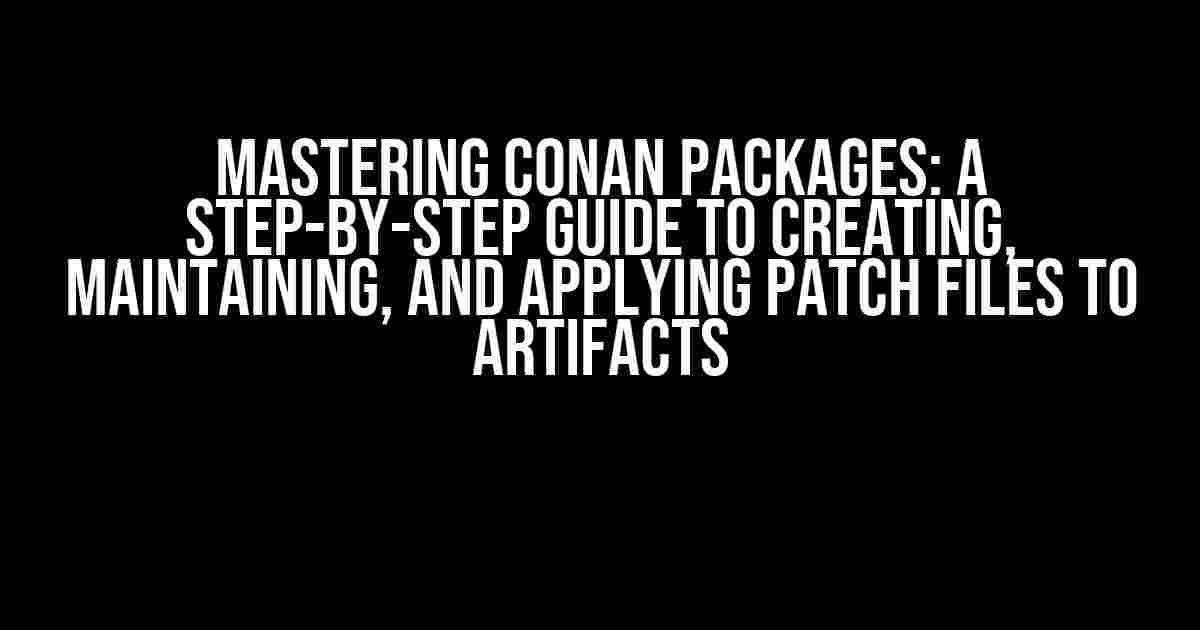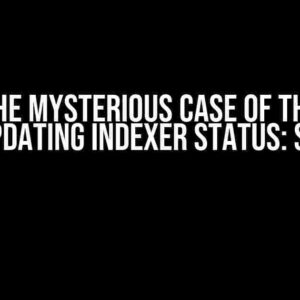Welcome to the world of Conan packages! As a developer, you’re likely no stranger to the concept of package management. But when it comes to creating, maintaining, and applying patch files to artifacts in consumed Conan packages, things can get a bit tricky. Fear not, dear reader, for we’re about to embark on a thrilling adventure to demystify this complex topic and empower you with the knowledge you need to take your Conan skills to the next level.
What are Patch Files, and Why Do We Need Them?
Before we dive into the nitty-gritty, let’s take a step back and understand the purpose of patch files. In the context of Conan packages, patch files are used to modify the source code of a package to fix bugs, add new features, or make other necessary changes. These changes can be applied to the original package source code or to the resulting artifacts, such as libraries or executables.
Think of patch files as a way to tailor the package to your specific needs, without having to modify the original codebase. This approach has several benefits, including:
- Flexibility: Patch files allow you to make targeted changes to the package without affecting the underlying code.
- Reusability: Patch files can be applied to different versions of the package, making it easy to maintain consistency across multiple projects.
- Customizability: By applying patch files, you can adapt the package to your project’s unique requirements, without compromising the integrity of the original code.
Creating Patch Files: A Step-by-Step Guide
Now that we’ve covered the why, let’s get to the how. Creating patch files involves a combination of technical know-how and attention to detail. Here’s a step-by-step guide to help you get started:
**Step 1: Identify the Changes**
Determine what changes need to be made to the package. This could involve debugging issues, adding new functionality, or optimizing performance. Make a list of the changes you want to implement, and prioritize them according to importance and complexity.
**Step 2: Create a Patch File Template**
--- a/original_file.txt +++ b/modified_file.txt @@ -1,3 +1,3 @@ -Original line 1 +Modified line 1 Original line 2 Original line 3
This is a basic patch file template, which includes the original file (a/original_file.txt), the modified file (b/modified_file.txt), and the changes made ( @@ -1,3 +1,3 @@ ). We’ll discuss the syntax and structure of patch files in more detail later.
**Step 3: Generate the Patch File**
Using a diff tool (such as `diff` or `git diff`), create a patch file that captures the changes you want to make to the package. For example:
$ diff -up a/original_file.txt b/modified_file.txt > patch_file.patch
This command creates a patch file (patch_file.patch) that contains the differences between the original file and the modified file.
**Step 4: Review and Refine the Patch File**
Inspect the generated patch file to ensure it accurately represents the changes you want to make. This is a critical step, as any errors or inaccuracies can lead to issues with the package.
Maintaining Patch Files: Best Practices and Considerations
Once you’ve created a patch file, it’s essential to maintain it properly to ensure its continued effectiveness. Here are some best practices and considerations to keep in mind:
**Track Changes and Updates**
Keep a record of changes made to the patch file, including the date, author, and description of changes. This helps you stay organized and ensures that changes are properly documented.
**Test and Validate**
Thoroughly test the patch file to ensure it works as expected. Validate the changes by building and testing the package with the applied patch file.
**Share and Collaborate**
Share your patch file with the Conan community or relevant stakeholders, and collaborate on updates and improvements. This helps to ensure that the patch file remains relevant and effective over time.
Applying Patch Files to Artifacts: A Step-by-Step Guide
Now that we’ve covered creating and maintaining patch files, let’s explore how to apply them to artifacts in consumed Conan packages.
**Step 1: Create a Conan Recipe**
Develop a Conan recipe that specifies the package and version you want to modify. For example:
from conans.tools import CMake
class MyPackage(Package):
name = "my-package"
version = "1.0"
description = "My modified package"
homepage = "https://example.com/my-package"
def build(self):
cmake = CMake(self)
cmake.build()
**Step 2: Apply the Patch File**
In the Conan recipe, apply the patch file to the artifact using the `apply_patch` method:
def build(self):
cmake = CMake(self)
cmake.apply_patch("path/to/patch_file.patch")
cmake.build()
This applies the patch file to the artifact, modifying the source code according to the changes specified in the patch file.
**Step 3: Build and Package**
Build the package using the modified Conan recipe, and package the resulting artifact for consumption:
$ conan build my-package/1.0@my-user/stable $ conan package my-package/1.0@my-user/stable
This creates a new package with the modified artifact, which can be consumed by other projects or shared with the Conan community.
Common Pitfalls and Troubleshooting Tips
When working with patch files and Conan packages, you may encounter some common issues. Here are some troubleshooting tips to help you overcome them:
**Syntax Errors**
Verify that the patch file syntax is correct, and that there are no formatting issues. Check for missing or mismatched @@ symbols, incorrect line numbers, or other syntax errors.
**Patch File Conflicts**
If multiple patch files are applied to the same artifact, conflicts may arise. Resolve these conflicts by merging the patch files or applying them in a specific order.
**Build Errors**
If the build process fails after applying the patch file, check the build logs for errors. Verify that the patch file is correctly applied, and that the changes are compatible with the package dependencies.
Conclusion: Mastering Patch Files in Conan Packages
Creating, maintaining, and applying patch files to artifacts in consumed Conan packages requires attention to detail, technical expertise, and a solid understanding of the Conan ecosystem. By following the guidelines and best practices outlined in this article, you’ll be well-equipped to tackle even the most complex patching tasks.
Remember, patch files are a powerful tool in the Conan package manager, allowing you to customize and adapt packages to your specific needs. With practice and patience, you’ll become a master of patch files and take your Conan skills to the next level.
| Keyword | Description |
|---|---|
| Create | Creating patch files involves identifying changes, creating a patch file template, generating the patch file, and reviewing and refining the patch file. |
| Maintain | Maintaining patch files involves tracking changes, testing and validating, and sharing and collaborating with others. |
| Apply | Applying patch files to artifacts involves creating a Conan recipe, applying the patch file, building and packaging the modified artifact. |
Frequently Asked Questions
Get the inside scoop on how to create, maintain, and apply patch files to artifacts in consumed Conan packages!
Q: What is a patch file, and why do I need it for Conan packages?
A patch file is a set of changes made to the source code of a package. You need it to apply fixes or alterations to the original package without modifying the original code. This way, you can maintain a clean and up-to-date version of the package while still benefiting from the changes you made. Think of it as a “source code diff” that’s applied on top of the original code!
Q: How do I create a patch file for a Conan package?
To create a patch file, you’ll need to modify the package’s source code, then use a tool like `git diff` or `diff` to generate the patch file. You can also use Conan’s built-in `conan patch` command to create a patch file from your local changes. Just run `conan patch` in your package directory, and Conan will generate the patch file for you!
Q: How do I apply a patch file to a Conan package?
To apply a patch file, you’ll need to use the `conan apply-patch` command. This command takes the patch file as an argument and applies it to the package’s source code. For example, `conan apply-patch my_patch.patch` will apply the `my_patch.patch` file to the package. Make sure you’re in the package directory when running the command, or specify the package directory as an argument!
Q: Can I maintain multiple patch files for different Conan packages?
Yes, you can! You can create and manage multiple patch files for different packages or even different versions of the same package. Conan allows you to specify the patch file(s) to apply when installing a package using the `conan install` command. For example, `conan install mypackage@version –patch=my_patch1.patch,my_patch2.patch` will apply both `my_patch1.patch` and `my_patch2.patch` to the `mypackage` package!
Q: Are patch files specific to a Conan package version?
Yes, patch files are typically specific to a package version. If you change the package version, the patch file might not be compatible anymore. Conan takes care of this for you by storing the patch file alongside the package version, so when you install a package, Conan applies the correct patch file for that version. This ensures that your patches are always applied correctly, even when switching between package versions!



